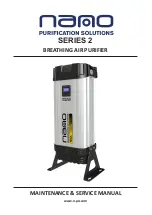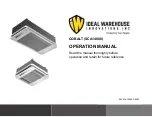
Revised May 2003
9
To get reasonable comfort and energy consumption, it is recommended that wall mounted thermostats be set at
21
°
C (70
°
F) for heating and 25
°
C (77
°
F) for cooling.
Over-adjusting the thermostat will not increase the rate at which a unit will heat or cool the space.
-- -- -- -- --
Cet appareil autonome de chauffage et de refroidissement a été soigneusement dessiné et construit pour assurer
un fonctionnement fiable quand il est installé correctement et bien entretenu.
DESCRIPTION DU SYSTÈME DE COMMANDE
L’appareil est commandé tant dans sa partie chauffage que climatisation par un thermostat au mur utilisant un
faible voltage.
Tout thermostat standard de 24 V de chauffage/ climatisation utilisé pour contrôler un appareil au gaz/ chauffage
assorti d’un ventilateur de refroidissement peut être programmé pour fonctionner avec cet appareil dans la
mesure où il y a suffisamment d’étapes de chauffage; cela comprend une permutation automatique et des
thermostats électroniques. Les appareils de 4 KW et moins, qui ont une étape de chauffage et les appareils de
4.5 KW et plus avec deux étapes de chaleur. Par conséquent, les appareils doivent être choisis en conséquence.
Un thermostat de pièce est fondamentalement un commutateur utilisé pour orienter une énergie de 24 volts à
partir d’un terminal « R » à ses terminaux W, (ou W1, W2), Y et G, selon la fonction commandée par l’utilisateur.
Parfois, un thermostat électronique doit être alimenté par 24 volts par l’entremise d’une connexion à un terminal
additionnel « C » ou « Commun », d’ordinaire quand l’affichage est éclairé de l’arrière. Si le thermostat
commande que la connexion « C » soit reliée au filage des terminaux, veuillez alors commander un graphite
additionnel qui sera inséré dans le connecteur de faible tension, n
o
de pièce 18BK23Y-024.
Le chauffage et la climatisation fonctionneront en cycle, programmé par le réglage du thermostat mural. Dans ce
mode, le côté de la salle où se trouve le ventilateur fonctionnera aux vitesses réglées en usine pour le chauffage
et la climatisation. Le ventilateur sera fermé s’il n’y a pas besoin de chauffage ou de climatisation.
Pour obtenir une consommation d’énergie raisonnable et se sentir bien dans la pièce, on recommande que les
thermostats muraux soient fixés à 21
°
C (70
°
F) pour le chauffage et 25
°
C (77
°
F) pour la climatisation.
Le surajustement du thermostat n’augmentera pas le rythme auquel l’appareil chauffera ou climatisera la
pièce.
OPERATING PROCEDURES --- PROCÉDURES D’EXPLOITATION
SUGGESTED OPERATING PROCEDURES
To obtain the maximum comfort from your Unitary Packaged heating, cooling unit, the following procedures are
recommended.
1. Always draw drapes or blinds in the summer, to block out direct rays from the sun.
2. Keep windows and doors closed when operating unit on cooling.
3. Prior to operating unit on cooling, ensure filter is clean for maximum efficiency.
4. Check filters regularly. Filters have to be cleaned in accordance with the unit environment. Never operate
unit with a dirty filter or without a filter.
5. Ensure that the air discharge and return air openings are not obstructed, causing a restricted air flow
condition.
DO NOT PLACE ARTICLES ON DISCHARGE REGISTERS.
6. When adjusting the thermostat, be careful not to over control. A change in temperature of plus or minus 2
degrees can make the difference between comfort and discomfort. Set the control at the recommended
comfort settings and allow the unit to operate at that setting. The unit will automatically maintain the comfort
level by cycling on and off as required.





























